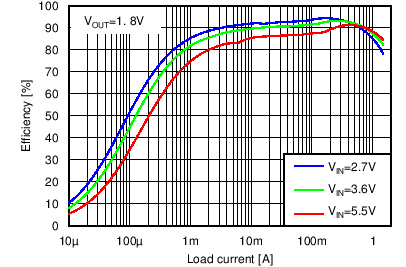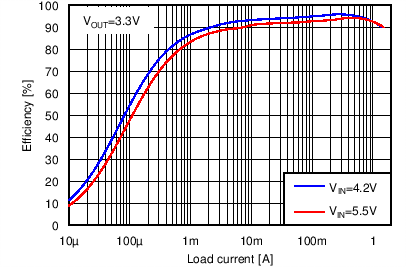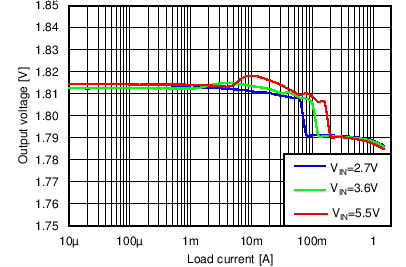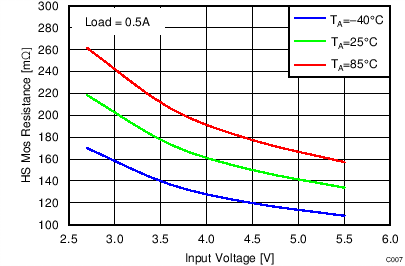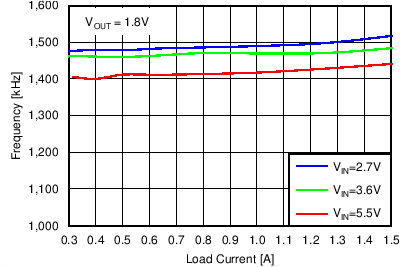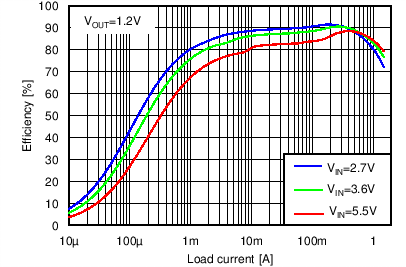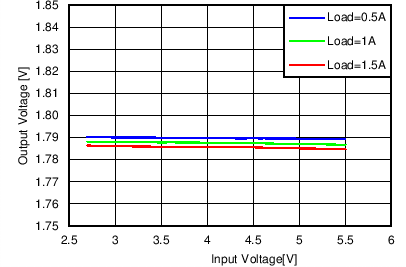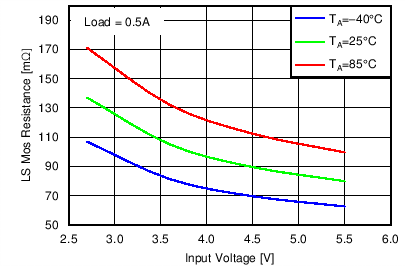ZHCSDM0B October 2013 – December 2014 TLV62565 , TLV62566
PRODUCTION DATA.
- 1 特性
- 2 应用
- 3 说明
- 4 简化电路原理图
- 5 修订历史记录
- 6 Device Comparison Table
- 7 Pin Configuration and Functions
- 8 Specifications
- 9 Parameter Measurement Information
- 10Detailed Description
- 11Application and Implementation
- 12Power Supply Recommendations
- 13Layout
- 14器件和文档支持
- 15机械、封装和可订购信息
8 Specifications
8.1 Absolute Maximum Ratings
Over operating free-air temperature range (unless otherwise noted)(1)| MIN | MAX | UNIT | ||
|---|---|---|---|---|
| Voltage(2) | VIN, EN,PG | –0.3 | 7 | V |
| SW | –0.3 | VIN+0.3 | V | |
| FB | –0.3 | 3.6 | V | |
| Sink current, IPG | PG | 660 | µA | |
| Continuous total power dissipation | See Thermal Information | |||
| Operating junction temperature, TJ | –40 | 150 | °C | |
| Storage temperature, Tstg | –65 | 150 | °C | |
(1) Stresses beyond those listed under absolute maximum ratings may cause permanent damage to the device. These are stress ratings only and functional operation of the device at these or any other conditions beyond those indicated under recommended operating conditions is not implied. Exposure to absolute–maximum–rated conditions for extended periods may affect device reliability.
(2) All voltage values are with respect to network ground terminal.
8.2 ESD Ratings
| VALUE | UNIT | |||
|---|---|---|---|---|
| V(ESD) | Electrostatic discharge | Human-body model (HBM), per ANSI/ESDA/JEDEC JS-001(1) | ±2000 | V |
| Charged-device model (CDM), per JEDEC specification JESD22-C101(2) | ±500 | V | ||
(1) JEDEC document JEP155 states that 500-V HBM allows safe manufacturing with a standard ESD control process.
(2) JEDEC document JEP157 states that 250-V CDM allows safe manufacturing with a standard ESD control process.
8.3 Recommended Operating Conditions(1)
| MIN | TYP | MAX | UNIT | ||
|---|---|---|---|---|---|
| VIN | Input voltage, VIN | 2.7 | 5.5 | V | |
| TA | Operating ambient temperature | –40 | 85 | °C |
(1) Refer to the Application and Implementation section for further information.
8.4 Thermal Information
| THERMAL METRIC(1) | TLV62565, TLV62566 | UNIT | |
|---|---|---|---|
| DBV (5 Pins) | |||
| RθJA | Junction-to-ambient thermal resistance | 208.3 | °C/W |
| RθJC(top) | Junction-to-case (top) thermal resistance | 73.7 | |
| RθJB | Junction-to-board thermal resistance | 36.1 | |
| ψJT | Junction-to-top characterization parameter | 2.3 | |
| ψJB | Junction-to-board characterization parameter | 35.3 | |
| RθJC(bot) | Junction-to-case (bottom) thermal resistance | N/A | |
(1) For more information about traditional and new thermal metrics, see the IC Package Thermal Metrics application report, SPRA953.
8.5 Electrical Characteristics
Over recommended free-air temperature range, VIN = 3.6 V, TA = -40°C to 85°C, typical values are at TA = 25°C (unless otherwise noted)8.6 Typical Characteristics
Table 1. Table of Graphs
| FIGURE | ||
|---|---|---|
| Efficiency | vs Load current (VOUT = 1.8 V, VIN = 2.7 V, 3.6 V, 5.5 V) | Figure 1 |
| vs Load current (VOUT = 1.2 V, VIN = 2.7 V, 3.6 V, 5.5 V) | Figure 2 | |
| vs Load current (VOUT = 3.3 V, VIN = 4.2 V, 5.5 V) | Figure 3 | |
| Output voltage | vs Input voltage (Line regulation, VOUT = 1.8 V, Load = 0.5 A,1 A,1.5 A) | Figure 4 |
| vs Load current (Load regulation, VOUT = 1.8 V, VIN = 2.7 V, 3.6 V, 5.5 V) | Figure 5 | |
| Quiescent current | vs Input voltage | Figure 6 |
| RDS(on) | vs Input voltage, High-Side FET | Figure 7 |
| vs Input voltage, Low-Side FET | Figure 8 | |
| Switching frequency | vs Load current, VOUT = 1.8 V | Figure 9 |
